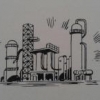Latest Downloads
-
 Water Bath Indirect Heaters
Water Bath Indirect HeatersArt Montemayor - Oct 12 2018 02:35 PM
-
 Petroleum: A Primer for Kansas
Petroleum: A Primer for KansasArt Montemayor - Oct 12 2018 02:27 PM
-
 Spray Tower for Flue Gas Scrubbing Design
Spray Tower for Flue Gas Scrubbing Designankur2061 - May 02 2018 02:31 PM
-
 Selection of Vertical Tanks
Selection of Vertical Tanksankur2061 - Apr 19 2018 07:42 AM
-
 Pressure Drop Calculator for Strainers 1
Pressure Drop Calculator for Strainers 1ankur2061 - Mar 24 2017 02:04 PM
-
 Horizontal Pig Trap System Design Guidelines
Horizontal Pig Trap System Design Guidelinesankur2061 - Jan 14 2017 02:54 PM
-
 Performance Prediction of 3-Stage Propane Refrigeration System
Performance Prediction of 3-Stage Propane Refrigeration Systemankur2061 - Aug 08 2016 02:43 PM
-
 Centrifugal Pump Troubleshooting Checklist
Centrifugal Pump Troubleshooting Checklistankur2061 - Dec 17 2015 08:18 AM
-
 Compressor Troubleshooting Checklist
Compressor Troubleshooting Checklistankur2061 - Sep 08 2015 11:43 AM
-
 Amine Sweetening Unit Preliminary Design
Amine Sweetening Unit Preliminary Designankur2061 - May 19 2015 09:35 AM
Popular Store Titles
 Tank Jacket Calculator
Tank Jacket Calculator
 Specification Sheet Collection
Specification Sheet Collection
 PIPESIZE
PIPESIZE
 Relief Valve Sizing
Relief Valve Sizing
 Rupture Disc Sizing
Rupture Disc Sizing
Chemical and Process Engineering Resources
Submitted Chris Haslego, Nov 21 2011 11:21 AM | Last updated Nov 21 2011 01:29 PM
| Category: | Refining |
| Question: | Can molten sulfur pose a safety hazard in a sealed tank? |
| Keywords: | sulfur,storage,tank,mawp,nitrogen,purge,design |
| Answer: | It depends on the type of tank in which the molten sulfur is stored. Molten sulfur is probably not stored in pressure vessels. It is more likely stored in cone roof, flat bottom tanks and such tanks can only withstand a vapor space pressure of 0.5 psig or less whether they are storing molten sulfur, or water, or fuel oil, or anything else.Sulfur per se does not generate explosive gases at normal conditions, I would like to make this clear. But the system (in reality) could emit this type of gases as molten sulfur (from refining industries) usually contains dissolved quantities of such a lot of gases (such as H2S).Your liquid is subject to stabilization (gas evacuation) while in the tank, so you must provide for removing the generated free gases (H2S ?) as they are formed and pose a potential over-pressurization hazard. To design for this problem you can:a. Use a convenient and available vacuum system to vent the accumulated gases as they are released and route them through the vacuum system to a flare header or through your scrubber. If you are in a refinery area, you should have access to this type of convenient answer.b. If you don't have a vacuum flare header available, you can supply your own blower system and evacuate the generated gases on demand as the pressure increases in the storage tank. For this, you need a dead band for the instruments to be able to function reasonably. In other words, you should have a design tank pressure ample enough to activate the blower operation and be able to shut the blower off at a lower pressure. This lower pressure should be safe-guarded from a vacuum condition which you cannot tolerate. Normally, you must be prepared to break a potential vacuum with atmospheric air. If your gases cannot be brought into contact with atm. air, you are forced to use an inert gas (Nitrogen) to break the vacuum or maintain as an inert blanket. Either way, you are going to have to confront this need to identify the compatability of your gases (whatever they may be) with air. Otherwise, you cannot design any further. This will be the first and number one issue when you meet for your Process Hazard Analysis. If you apply Nitrogen, and evacuate at a rate to keep the vapor space purged continuously, the pressure could be a variety of values only subject to the tank's MAWP (Max. Allowable Working Pressure) which is set by you. |
Forum Quick Links
Tech Q & A Category List
-
 Bulk Solids
Bulk Solids
-
 ChE Outside the Plant
ChE Outside the Plant
-
 Chemical Process Business
Chemical Process Business
-
 Chemistry Basics
Chemistry Basics
-
 Corrosion
Corrosion
-
 Equipment Design
Equipment Design
-
 Experimentation and Testing
Experimentation and Testing
-
 Fluid Dynamics
Fluid Dynamics
-
 Heat Transfer Technology
Heat Transfer Technology
-
 Industrial Utilities
Industrial Utilities
-
 Mass Transfer
Mass Transfer
-
 Physical Property Information
Physical Property Information
-
 Plant Basics
Plant Basics
-
 Plant Economics
Plant Economics
-
 Preparing to Become an Engineer
Preparing to Become an Engineer
-
 Process Control
Process Control
-
 Reactions and Processes
Reactions and Processes
-
 Refining
Refining
-
 Safety
Safety
-
 Separation Technology
Separation Technology
-
 The Environment
The Environment
-
 Thermodynamics
Thermodynamics

 FB
FB



0 Comments